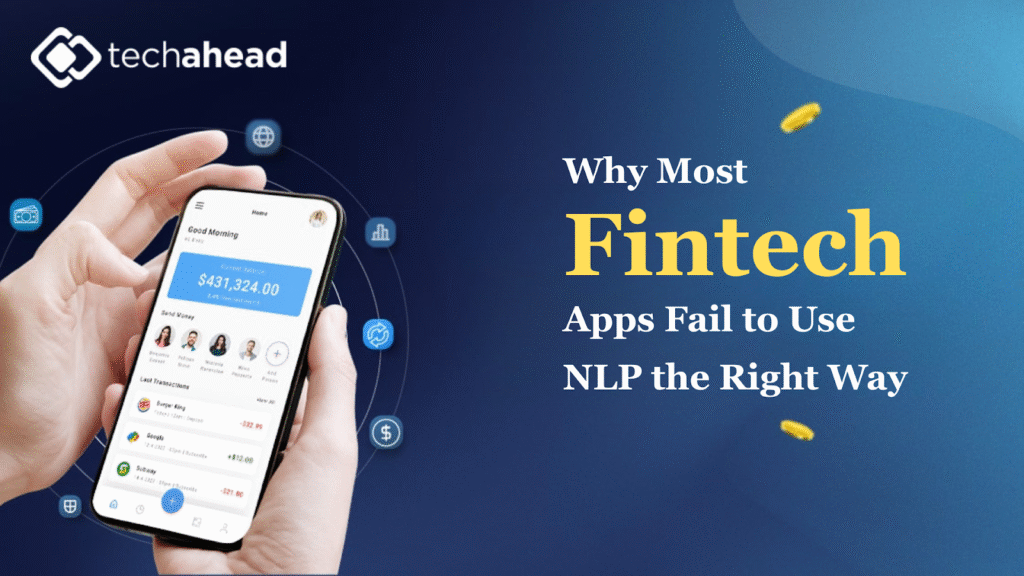From personal budgeting to stock trading and digital banking, fintech apps have made finance faster and more accessible. But something still feels off in many of them.
A lot of apps can show your balance, send alerts, or process payments. What they often miss is understanding. When users ask questions in plain language or search for past transactions in their own words, the app doesn’t get it. This is where Natural Language Processing (NLP) is supposed to help, but in most cases, it doesn’t.
The problem isn’t the idea. It’s how teams execute it. Behind every successful NLP feature, there’s often an experienced NLP development company that knows how to apply it. However, that part gets skipped far too often.
What Fintech Apps Get Wrong About NLP
It’s not that NLP doesn’t work but that it rarely gets implemented with the right mindset. A lot of fintech apps claim to use AI or language tech, but very few actually solve a user’s problem with it. What users expect and what they actually get keeps slipping away.
Misunderstanding NLP’s role
NLP is often perceived as an add-on instead of core to a product. Add a chatbot, and the job’s done. NLP’s job isn’t just to spit out answers. It should understand what the user really means, how they’re feeling, and why they’re asking. Without that, the whole thing falls flat.
Feature vs. experience gap
It’s easy to check off “AI” or “chatbot” in a product spec. But that doesn’t mean users are getting smarter support. In reality, they’re clicking back, trying to rephrase, or dropping off entirely.
Setting unrealistic expectations
Many applications advertise “AI-powered assistance” or “smart assistants”, only to find that the feature they are using has a fixed set of defined rules. Users feel let down when they try to engage naturally and hit a dead end.
NLP in Fintech: It’s More Than Just Chatbots
When NLP is used correctly, users barely notice it. When it’s done right, NLP blends into the way users move through the app. But most products fall short. They get stuck on surface features and miss what NLP can actually do underneath.
Contextual search and queries
Typing something like “How much did I spend on groceries last month?” feels more natural than digging through filters. But for that to work, the app needs to understand what “groceries” actually means for each person.
Document and message analysis
NLP can alleviate some of the workload by conducting KYC paperwork and checking documents and service messages. However, this only works if the system is trained or it has the capacity to confuse rather than support the user.
Multilingual customer support
In markets with regional language diversity, NLP can offer translated, localized support. Done right, this builds trust and boosts retention.
Smart classification & data extraction
NLP can help tag transactions, make sense of spending patterns, and catch unusual activity without slowing things down. But again, the model has to be trained on the right data.
The Real Cost of Poor Implementation
A feature that sounds good can turn into a liability if it doesn’t work in real-world use. Poor NLP isn’t just a missed opportunity but a credibility risk. Most users won’t give it a second chance.
Bad user experience
A broken chatbot or misunderstood query is worse than no feature at all. It frustrates people. When an app constantly misreads what they’re asking, it starts to feel pointless. Eventually, they stop bothering because it just doesn’t feel useful anymore.
Loss of trust and engagement
Miss the mark a few too many times, and users check out. Some stop using the feature altogether. Others just stop opening the app.
Maintenance burden over time
A poorly built NLP doesn’t just break, it keeps breaking. Instead of helping the product grow, it adds overhead.
What Smart NLP Integration Looks Like
It’s easy to say “make it smart.” The real challenge is in the details. You can’t just build NLP once and walk away. It takes smart design, real user feedback, and a team that knows how to work together.
Intent-first design
It begins with finding out what users are actually trying to achieve, not just what they are typing, and what they are trying to do? Instead of being focused on keywords, a good NLP design is focused on meaning.
Continuous learning from user input
The best apps improve over time. They learn from failed interactions and adjust. That takes feedback loops, not just static models.
Product, UX, and NLP teams working together
When designers, developers, and specialists in NLP actually get into a room, the result is usually smoother. Everyone’s working on the same outcome: clarity.
How a Fintech App Development Company Can Help
Most internal teams don’t have deep NLP experience, and that’s fine. But skipping expertise altogether isn’t. Teaming up with the right fintech app development company can turn a rough idea into something real and usable.
The good ones ask the right questions before they even open a code editor:
- What problem is this NLP feature supposed to solve?
- Does it actually fit into how the rest of the app works?
- Can it be tested, improved, and scaled?
They also understand compliance, security, and how to make AI decisions that work in finance.
Final Thought
Most fintech teams don’t fail because they ignore NLP, they fail because they don’t use it with purpose. A good NLP feature doesn’t need to stand out. It should do its job quietly by helping people find what they need, make choices, and keep things moving.
When it’s built well, it just feels like the app “gets it.” But that doesn’t happen by accident. You have to treat NLP like a core product decision, not a side feature. That’s the difference between something users skip over and something they come to rely on.




